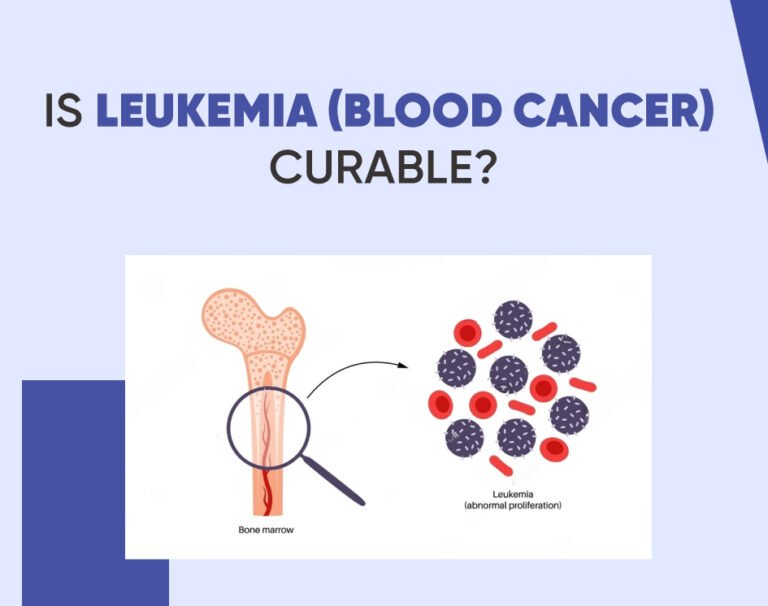
Is Leukemia (Blood Cancer) Curable?
Leukemia is commonly known as blood cancer. It is a severe medical condition that affects the blood and bone marrow. In the case of acute lymphocytic leukemia (ALL) in children, the current 5-year survival rate stands at approximately 90%. Conversely, the likelihood of surviving for 5 years or longer may be comparatively lower for other leukemia types. It happens when the body generates too many abnormal white blood cells. This results in impairing the body’s ability to fight infections. Many people wonder whether leukemia is curable or not. In this comprehensive guide, we will explore the various treatment options available for leukemia and delve into its curability.
What is Leukemia?
Leukemia, a form of cancer, begins in the bone marrow, where blood cells are made. This condition results in an overabundance of abnormal white blood cells. What happens then? It can impair the body’s ability to fight infections and cause various symptoms. There are different types of leukemia, including acute myeloid leukemia (AML), acute lymphocytic leukemia (ALL), chronic myeloid leukemia (CML), and chronic lymphocytic leukemia (CLL). Every type of leukemia has its distinct traits and requires specific treatment methods.
Symptoms of Leukemia
Leukemia symptoms vary based on the leukemia type and disease stage. Some common signs/symptoms are as follows:
Fatigue and Weakness
Individuals with leukemia often experience persistent fatigue and weakness, even after getting adequate rest. This fatigue may interfere with daily activities and weaken one over time.
Frequent Infections
Leukemia can compromise the immune system, leaving individuals more vulnerable to infections. Common infections may involve respiratory, urinary tract, and skin infections.
Easy Bruising or Bleeding
Leukemia can affect the body’s ability to produce usual blood clotting factors. The result? It leads to easy bruising, bleeding gums, nosebleeds, or prolonged bleeding from minor cuts or injuries.
Swollen Lymph Nodes
Enlarged lymph nodes, particularly in the neck, armpits, or groin, may occur in some individuals with leukemia. These swollen lymph nodes may feel painless or tender to the touch.
Bone Pain
Leukemia can cause bone pain, especially in the long bones of the arms and legs. This pain may worsen at night or during physical activity and may be accompanied by joint pain or stiffness.
Unexplained Weight Loss
Some people with leukemia might experience unexplained weight loss. It doesn’t matter if they maintain their usual diet and activity level. This weight loss may be due to a combination of factors. The loss of appetite and metabolic changes associated with cancer can be some of the reasons.
Fever and Night Sweats
Fever and night sweats are common symptoms of leukemia. It is particularly in individuals with acute forms of the disease. These symptoms may occur intermittently and be accompanied by chills or other flu-like symptoms.
You have to keep in mind that many of these symptoms are nonspecific. Various other medical conditions can be the culprit. If you experience persistent or unexplained symptoms, consult a healthcare professional for proper evaluation and diagnosis. Early detection and prompt treatment can significantly improve the outlook for individuals with leukemia.
Treatment Options for Leukemia
The treatment for leukemia depends on various contributors. This can be the type of leukemia, the patient’s age, overall health, and the extent of the disease. The primary treatment modalities for leukemia consist of:
Chemotherapy
Chemotherapy utilizes potent medications to eliminate or inhibit the growth of cancer cells. It is often the first line of treatment for leukemia, especially in acute cases.
Targeted Therapy
Targeted therapy employs drugs or substances to pinpoint and combat specific cancer cells, sparing healthy cells from damage. This treatment option is more precise and targeted than traditional chemotherapy.
Bone Marrow Transplantation
In some cases of leukemia, a bone marrow transplant may be recommended. In this process, a donor replaces damaged or diseased bone marrow with healthy stem cells.
Immunotherapy
Immunotherapy works by enhancing the body’s immune system to aid in combating cancer. It can be used alone or in combination with other treatments to target leukemia cells.
Is Leukemia Curable?
The prognosis for leukemia varies depending on several variables. These factors include the type of leukemia, disease stage, and treatment response. Some forms of leukemia can be cured with intensive treatment. In contrast, others may require ongoing management to control the disease and prolong survival. Nowadays, medical technology is advancing, and research efforts are also going on at the same time. Thus, the outlook for patients with leukemia continues to improve. So, we can hope for a cure in the future.
Winding Up
Leukemia presents significant challenges in terms of diagnosis and treatment; it is not necessarily a death sentence. Prompt diagnosis, appropriate treatment, and ongoing support are necessary for the patient. With this, many individuals with leukemia can achieve remission and lead fulfilling lives. It is essential to consult with a qualified healthcare professional to discuss the best treatment options based on individual circumstances. Remember, early detection and proactive management are crucial to improving outcomes for patients with leukemia.






